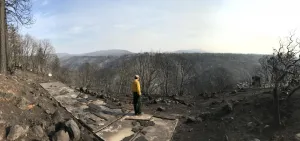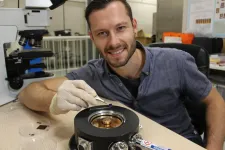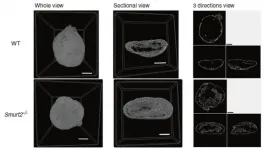The Camp Fire was the costliest disaster worldwide in 2018 and, having caused 85 deaths and destroyed more than 18,000 buildings, it became both the deadliest and most destructive wildfire in California's history, two records the fire still holds today.
What made the Camp Fire so devastating? And what lessons can we learn to prevent another disaster of this scale? Researchers at the National Institute of Standards and Technology (NIST) have begun to answer these questions by investigating the conditions leading up to the fire and meticulously reconstructing the sequence of events describing the first 24 hours of its progression. A new report containing the timeline identifies areas where more research is needed to improve life safety and reduce structural losses. It also offers a detailed look at how a large and deadly fire advances -- information that will become increasingly valuable as fire seasons continue to intensify.
"The information we collected on the timeline is extremely powerful by itself, not only for Paradise but for other similar communities, to help them understand what they may encounter and better prepare, whether it is at a community or at the first responder level," said NIST fire protection engineer Alexander Maranghides, who led the timeline reconstruction.
To piece together the puzzle of the Camp Fire, the team carried out discussions with 157 first responders, local officials and utilities personnel who were present during the fire. The team documented sightings of fire or smoke and efforts to fight the fire or evacuate, as well as insights into community preparedness and weather conditions.
The researchers sought to back up observations made during the fire with additional data sources before adding new puzzle pieces to the timeline. With the help of the California Department of Forestry and Fire Protection (CAL FIRE), Paradise Police Department and others, the team gained access to and reviewed large data sets, including radio logs, 911 calls, dashboard and body camera recordings, and drone and satellite images. They also looked to images in social and news media to corroborate the sightings of discussion participants.
By the end of the painstaking process, the authors of the report incorporated more than 2,200 observations into the timeline, which is broken up into 15 separate segments to capture concurrent events throughout different sections of Butte County.
The team's investigation revealed several conditions throughout Butte County that, taken together, created favorable conditions for an inferno. On the day the fire broke out, wind gusts were powerful, blowing up to about 48 kilometers (30 miles) per hour, and were almost exclusively pointed southwest, toward Paradise and the smaller communities of Magalia and Concow. The 200 days of drought preceding the fire had also transformed much of the region's lush terrain into combustible ground.
And perhaps counterintuitively, Maranghides said, the relatively large distance between the fire's origin and the edge of Paradise (about 11 kilometers, or 7 miles) contributed to the massive, 3.2-kilometer (2-mile)-long fire front that crashed into the town.
"If a fire starts far away, upwind, then it has time to develop and expand. By the time it hits the community it is so large and so powerful that it could wipe everything out," Maranghides said. "But if it ignites closer, the fire can be so much smaller. It takes a much smaller bite out of the community, and people may have a fighting chance."
The report indicates that town officials in Butte County went to great lengths to prepare for fires, having cleared vegetative fuels near critical infrastructure and bolstered emergency communications in the weeks and months prior. However, dense vegetation had still accumulated throughout Paradise -- a factor enhanced by the nearly 100 years the town had gone without experiencing a wildfire.
The researchers learned that, although Paradise made resources available for residents to remove trees, many did not take the city up on its offer. One participant in the reconstruction noted that residents were often attracted to the lifestyle of "living in the forest" provided by the town.
With a gamut of unfavorable conditions at play, a spark in the wilderness quickly became a raging inferno.
The fire's siege on Paradise, which ultimately destroyed 85% of the town's buildings, began before its front line reached the city limits. Showers of burning debris were carried by the wind ahead of the main fire into town, where the embers ignited buildings and vegetation, riddling the town with dozens of smaller fires that ate up precious firefighting resources.
Propelling the Camp Fire's structure-destroying spree were fires that spread within and between plots of land, or parcels, rather than from the fire front. Sources such as burning sheds, plants, vehicles and neighboring houses caused many buildings to catch fire, either through direct contact with flames or embers generated in parcels.
Paradise's defenses quickly fell once the fire front reached town. The incident commander leading the emergency response recognized the fire's speed and intensity and ordered his personnel to abandon all firefighting efforts just 45 minutes after the fire arrived. "Save lives, keep evacuation moving," the incident commander said over the radio.
Although the focus of emergency response narrowed on saving lives, evacuation efforts were stifled by burnovers -- life-threatening events in which residents or first responders are overrun by flames, cutting them off from escape routes. Across Paradise and Concow there were 19 burnovers at least, some of which involved downed power lines or flaming vegetation that blocked off roads, causing gridlock and putting lives in danger.
In the past, recorded burnovers were sparse, with reports attributing few or none to most fires. Hardly any have been scrutinized as heavily as the Camp Fire, however, which could partially explain the event's high number of documented burnovers. Another critical contributor was likely Paradise's heavily wooded nature, Maranghides said.
The abundance of burnovers during the Camp Fire may not be an isolated event, but part of a larger trend, particularly for communities where vegetative fuels have built up over many years.
"The significant activity we've experienced in the last few years may indicate that burnovers are becoming more frequent than they used to be," said CAL FIRE chief Steven Hawks, a co-author of the report. "My sense is that because fires are burning so fast now, there is more potential for people to become trapped."
With this report, NIST has shone light on the many aspects of the Camp Fire's multipronged attack. Research into these threats could fill critical knowledge gaps, paving the way for science-based codes, standards and practices that could help communities outsmart fires.
What's urgently needed, the authors write, are methods of capturing the severity of burnovers and a better understanding of how they occur in the first place. Studies in this area could make way for guidelines on reducing their likelihood and protecting evacuation routes.
As for buildings, there are already two known options for increasing their chances of surviving a wildfire. The first is to make sure combustible items within a parcel (plants, sheds, etc.) are not too close to a structure, and the second is to increase the fire resistance of a structure's materials. But striking a cost-effective balance between the two is difficult with the limited information on how various fuel sources threaten buildings.
"We need to improve our understanding at the parcel level because it's the parcel-level exposures that drive the building's survivability," Maranghides said. "You cannot just look at the building in absence of what's around it."
Once researchers can put numbers to the behavior of embers and combustibles in parcels, it may become more clear what a particular building needs in terms of spacing and hardening to hold up to a wildfire.
City officials could use the report's timeline for emergency planning as well. By having a detailed description of events such as burnovers in front of them, members of city councils or public works departments in wildfire-prone regions could evaluate their own emergency plans and potentially identify vulnerabilities.
There is currently no standard method of comparing the wildfire hazards of communities. So, although the researchers could draw individual similarities between Paradise and other communities in Northern California, they were unsure how the town compared as a whole. The team aimed to bridge this gap by developing a framework in the form of a document encouraging city officials to record specific information on fuels, population, emergency notifications and other aspects of the community.
If adopted and employed statewide in California and in other wildfire-prone areas, the framework, which appears in the report, could reveal areas most at risk and worthy of attention and resources, Maranghides said.
In the hands of first responders, the new report could become valuable training material. Using data on how quickly and intensely the fire grew, commanders could build tabletop exercises to practice deploying firefighting resources to counter its spread and save lives.
An event on the scale of the Camp Fire makes it clear that action is needed at all levels to protect communities from wildfires, Hawks said. And that need is perhaps more urgent now than ever.
"Going forward, there's no reason to believe that fire activity and severity is going to lessen anytime soon," Hawks said. "We're never going to get rid of wildfires, natural or human-caused. But we can learn how to live with and work together to mitigate them."
The full report is now available, along with several maps portraying the fire spread. The timeline of fire progression will form the basis for subsequent reports on evacuation and emergency response during the Camp Fire that the NIST team plans to publish in the coming months.
INFORMATION:







